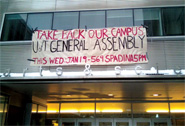
Photo: CUPE 3902
General assembly created out of lack of confidence in current governance of the university.
More than 200 academic staff, students, alumni and friends of the University of Toronto community held a first “general assembly” last month to mark the beginning of a campaign to establish an alternative governance structure at the university.
“The campus constituents involved have many divergent experiences, but one concern we all share is that the administration isn’t listening to us,” said Scott Prudham, an associate professor of geography and vice-president of the University of Toronto Faculty Association, one of the groups that organized the meeting of the new body.
“We are seeing autocratic tendencies from our administration across several fronts that I would describe as nothing short of dangerous — dangerous to students, dangerous to staff and dangerous to our faculty and librarians,” Prudham added. “These developments compromise the core values of the institution.”
Prudham lists as constituent concerns actions by the university administration in recent academic planning initiatives such as a sweeping proposal introduced last year to disestablish the world-renowned Centre for Comparative Literature and create a new School of Languages and Literature that would house six previously autonomous units.
The restructuring plan drew harsh criticism and prompted fierce opposition within the university community and from scholars around the world. The faculty association filed a grievance saying the changes “would have a negative impact on faculty and librarian appointments.” The plans were eventually dropped. But UTFA isn’t reassured — its grievance remains unresolved.
A simmering atmosphere of distrust was brought to boiling point in 2008 when U of T president David Naylor’s planning document called “Towards 2030” was adopted by the governing council, despite being earlier defeated in a non-binding referendum vote. And later that year, the university administration imposed library user fees, provoking enormous anger among students, parents, and faculty across the country.
In 2009, the Faculty of Arts and Science moved to a program fee tuition model for new students, eliminating the per-course fees. The change sparked opposition protests from student groups and their allies who viewed the flat fee model as a money grab that diminished accessibility.
Last June, university administrators closed most of the campus during the G20 Summit in Toronto, without consulting faculty, staff and students who would be affected by the closure. The unilateral decision was widely criticized by students’ unions and other campus and labour groups.
The unfolding moves have raised the hackles of many in the campus community who say the governing bodies are running the university like their personal fief — the issue that set the stage for the general assembly and drew a packed house Jan. 19. Much of the crowd at the ‘take back our campus’ event shared accounts of their attempts to raise concerns with the U of T administration, only to be met with closed doors.
Vivien Endicott-Douglas, a part-time undergraduate student and a member of the event organizing committee, said for the administration to ignore or fail to account for any group on campus is to act against the best interests of the university.
“We have huge classes, huge fee hikes, closed-door meetings, and in the day-to-day running of this place, we feel totally shut out and treated like numbers. The University of Toronto thinks we can’t make decisions for ourselves. Tonight we proved we can,” she told the gathering.
Midway through the event participants broke into different issue-based working groups to share ideas and provide action plans on topics from academic planning and university student life to anti-corporatization, among others.
CUPE 3902 chief steward Morgan Vanek says she’s optimistic about the experiment in self-government that brought together a variety of perspectives on learning and working conditions. “Cafeteria workers, faculty, students and librarians sitting shoulder to shoulder and actually having serious conversations about how this university should be run — this is what collegial governance at our university should look like.”
She said she’s expecting assembly members to convene again before April.